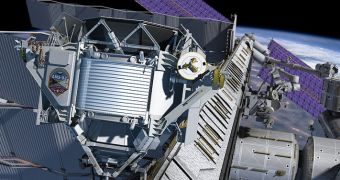NASA engineers have just received the $2-billion Alpha Magnetic Spectrometer (AMS), the largest and most complex scientific experiment that will be attached to the International Space Station (ISS). The instrument is scheduled to fly to low-Earth orbit (LEO) this April.
It will be ferried to space aboard space shuttle Endeavor, which was originally supposed to launch in February. But delays suffered by Discovery have forced its take-off, initially planned for early November 2010, to bump Endeavor's flight from February to April.
The AMS was delivered from the CERN (European Organization for Nuclear Reasearch) Labs to NASA in anticipation of integration aboard the shuttle for its planned launch date. This experiment is critical important for a variety of reasons.
The most important is that it could finally help astrophysicists solve the issues of dark matter and antimatter, two concepts that need further clarification. These types of matter are also very elusive, which makes it very difficult for scientists to analyze them.
Then, the instrument could help investigators answer some relevant questions about the Universe as a whole, such as for example how come galaxies have enough mass to allow for the stars within to orbit at such high speeds.
Experts have known for a long time that something was off about this, and one of the roles of dark matter is to account for the so-called missing mass that experts cannot detect. The stuff is believed to interact with normal matter through gravitational pulls alone .
“We know the gas between galaxies in the Universe was ionized early in history, but the total light from these new galaxies may not be sufficient to achieve this.” explains University of Oxford expert Andrew Bunker, quoted by Daily Galaxy.
It is very important for the AMS to detect dark matter because it could confirm several astronomical hypothesis in the process, but also because physicists cannot create the stuff artificially.
Using particle accelerators such as the Large Hadron Collider, scientists were able to produce small amounts of antimatter, but with tremendous difficulty and effort.
Experts hope that the most expensive orbital experiment ever will help them make this effort a lot easier, and reach promising results in a short period of time.

 14 DAY TRIAL //
14 DAY TRIAL //